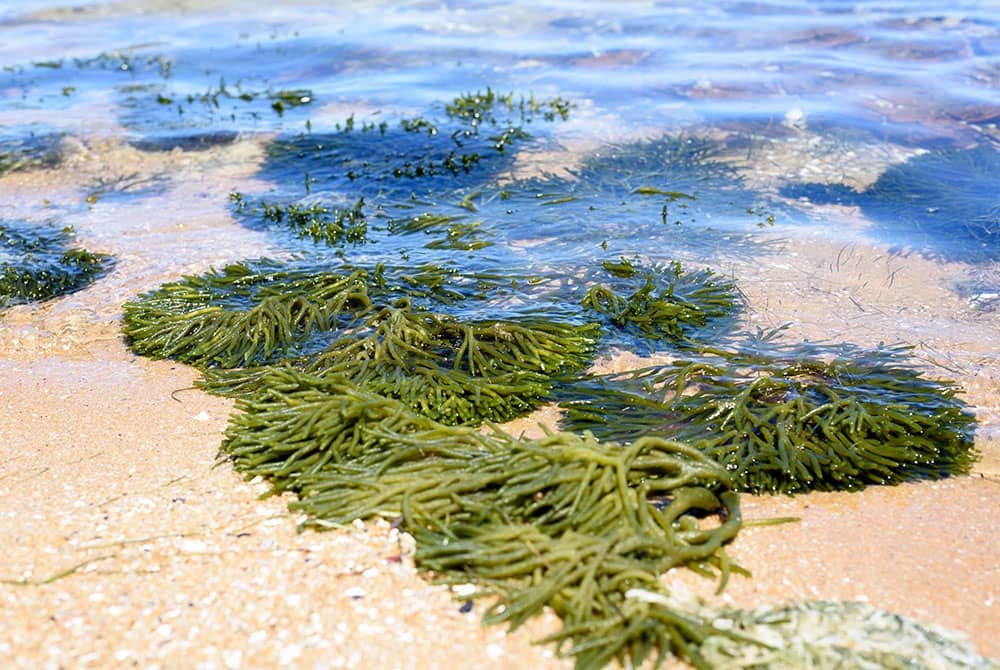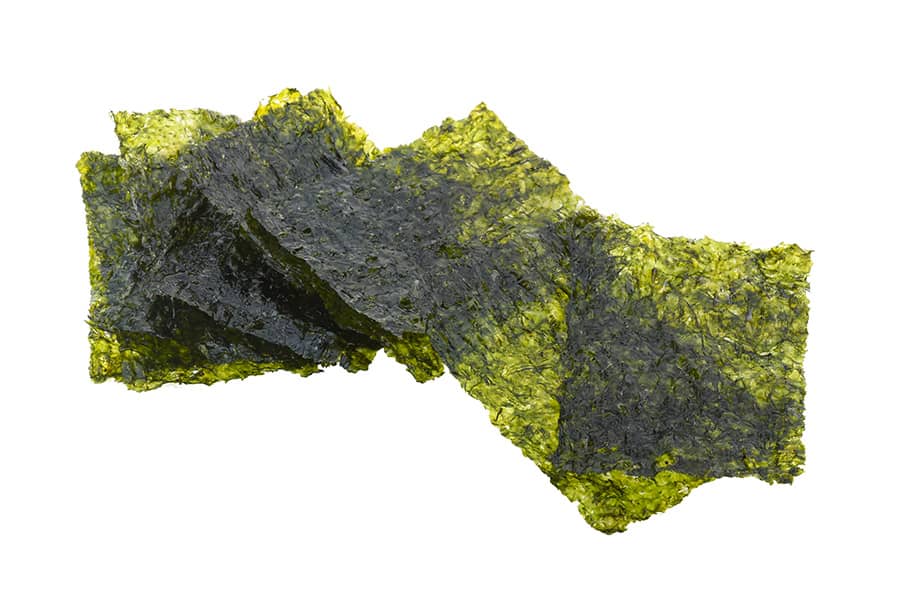
Uses of Seaweed have been around for a long time. In recent years, seaweed has become more and more popular for use in agriculture, providing food, the source material for various chemical uses, cattle feeds, and fertilizers.
Over 80% of seaweed production and harvesting is for human consumption directly.
What is Seaweed?
There are two main types of algae: the macroalgae (seaweeds), which occupy the littoral zone and can be of very large size, and the small-sized microalgae, which are found in benthic and littoral habitats as well as throughout the ocean waters as phytoplankton.
There are thousands of species of macroscopic, multicellular, marine algae, that can grow in a wide range of sizes from minuscule to gigantic.
Seaweed has a variety of uses and below we’ll look in the most popular uses of seaweed.
What Are the Interesting Uses of Seaweed?

1. Food
Seaweed is popular as food across the world, mostly in East Asia and Australia. The people living on the sea coasts in these countries commonly use fresh seaweeds as food. Plants can be dried after harvesting and then cut into strips or powdered. In Japan, for example, kombu is used in the preparation of fish, meat dishes, soups and also as a vegetable with rice. Powdered kombu is then used either added to rice in the same way as curry or in sauces and soups.
In preparation of salad and soups specific green seaweeds are used.
Alginate, agar and carrageenan are gelatinous seaweed products collectively known as hydrocolloids or phycocolloids. Hydrocolloids are food additives. In foods such as meat and poultry products, confectionery, desserts and beverages, and moulded foods is used Agar. Carrageenan is used in salad dressings and sauces, dietetic foods, and as a preservative.
2. Climate Change
There is a proposal for farming seaweed for carbon removal. It’s called Ocean afforestation and it has the potential to reduce carbon dioxide concentrations in the atmosphere since macroalgae absorb carbon dioxide.
This could also be used as a renewable liquid fuels equivalent. It will also increase ocean primary production, biodiversity, and food for people while removing CO2 from the atmosphere.
Carbon dioxide removed from the atmosphere by the world’s ocean ecosystems can take up to 20 times more CO2 from the atmosphere than land-based forests. China could remove its entire phosphorus effluent by increasing seaweed production by 150%.
3. Edible Packaging
Uses of Seaweed find their way also as a source to produce edible packaging. University of San Diego researchers also turn to seaweed and algae as the solution for reducing the plastic in packaging. These low-calories wrappers can be used as edible packaging for snacks and add extra nutritional value to your food like vitamins, minerals as well as polysaccharides.
Seaweed-based packaging as a replacement for plastic will help the waste management process because it is biodegradable and environmental-friendly. Companies like Evoware are trying to find environmentally friendly, biodegradable, edible and nutritious products used for packaging.
Reducing plastic usage (Single-use plastic makes for more than 50% of the plastic waste problem) is going to reduce not just the carbon dioxide emissions into the atmosphere but also the plastic pollution.
4. Fertilizers and Soil Conditioners
Many countries such as Japan, France, United States, England and South India start using seaweeds as fertilizers due to the presence of potassium chloride (KCI). Seaweed extracts have given positive results in many applications and widely used in the horticultural industry.
In India for example, in coastal areas of Tamil Nadu and Kerala., as manure for coconut plantation are used freshly collected and cast ashore seaweeds in the form of compost.
Seaweed manure seems to increase resistance to disease, because the nitrogen compounds and nutrients are in ionic form and a quick absorption by crops, which leave less to reach to the soil microflora.
5. Bioremediation
Seaweeds have the potential to reduce nutrients from aquaculture systems by a sustainable treatment method bioremediation that reduces the impact of this pollution on the marine environment by using biological organisms.
During bioremediation, microbes utilize chemical contaminants in the soil as an energy source. Availability of water affects diffusion of water and soluble nutrients into and out of microorganism cells.
For example in South Africa, raw materials from the seaweed industry is used for bioremediation of both the atmospheric and aquatic environments.
6. Wastewater Treatment
Macroalgae (seaweeds) consume carbon dioxide and release oxygen during wastewater treatment. In integrated fish farming systems, seaweeds can remove up to 90% of the nutrient discharge from an intensive fish farm.
Seaweeds are an effective alternative approach for aquaculture-generated wastewater treatment to improve water quality and revenue yielding business for farmers.
Shellfish and seaweeds can provide good ecosystem services by extracting organic and inorganic nutrients from seawater.
Charles Yarish, Stamford professor of ecology and evolutionary biology

7. Medicine and Herbs
According to Journal of Applied Phycology, seaweeds are the richest source of vitamins, especially vitamins A, B and E. Vitamin C content is about 1.5 times that of oranges. Essentially required for the development of the human body is vitamin B. Seaweeds are also a good source of protein, carbohydrates, fiber and minerals.
There are studies showing good result and it may help with diabetes, to support gut health, or even it may help with weight loss and protect the heart.
Seaweed extract is used in some diet pills, while other seaweed pills exploit the same effect as gastric banding, expanding in the stomach to make the stomach feel more full. Paste mixtures are also used in massage creams, with promises to rapidly restore elasticity and suppleness to the skin.
8. Biomass for Fuel
harvest it and convert it to methane by a process of anaerobic fermentation. More work and engineering is necessary to find better methods for the conversion step, biomass to methane, on a large scale and for the design of suitable open-ocean structures.
Professor Mike Allen of the University of Exeter has announced a method for processing seaweed to facilitate biofuel production in the Journal of Chemical Technology and Biotechnology.
A genetically engineered a new strain of E. coli bacteria, done by Adam Wargacki and colleagues at the Bio Architecture Lab in Berkeley, California have been successful that feed on the sugars found in brown seaweed and transform the sugars into ethanol.
9. Animal Food
Other interesting uses of seaweed are as food for livestock. According to an article published in the journal Plos One researchers found that seaweed added to cattle feed over five months reduced their methane expulsion.
Methane is a greenhouse gas that is 30 times more potent than carbon dioxide. Scientists focused on studying the red seaweed species, called asparagopsis taxiformis—which thrives in tropical and sub-tropical climates.
The livestock sector is a contributor to global warming with 14.5 percent of global greenhouse gas emissions. There almost 1.5 billion head of cattle in the world, according to the Food and Agriculture Organization of the United Nations.
10. Cosmetics
Often you’ll find on the list of ingredients on cosmetic packages, particularly in the face, hand and body creams or lotions, extract of seaweed. The extract can be used in 2 ways: either as an agent in the preparation of products or as a therapeutic agent itself.
Seaweed are rich in antioxidants that can help prevent free radical damage to the skin and protect against skin aging.
Alginates is used as a thickening and dispersing agent in liquid emulsions, cream, jellies, lotions, compact powders, toothpaste, soaps etc. Manufacture of soaps and alums are using alkalies prepared from seaweed ashes.
Final Thoughts
There is no doubt the potential of uses of seaweeds in many important aspects of our economy. They can be used not only to solve the hunger crises but it can be a strong factor in the fight against climate change.
The application of seaweeds is growing from bio-fuel technology, wastewater treatment, therapeutic biomolecule identification, to nutritious food sources, bio-fertilizers, and cosmetics, etc.
Seaweed farms are growing and generating a better income compare to fishing. If seaweed become an economically feasible industry in Europe and North America, the production costs must be reduced.



